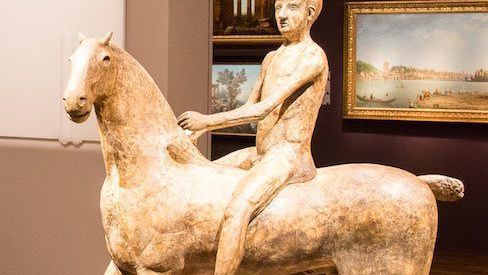

Words: Gentleman's Journal
George Eliot, the conscience of British literature, famously asked, “what do we live for, if not to make life less difficult for other people?” The answer lies in the imaginative splendour of Eliot’s writing: we live for beauty. On a redbrick Georgian house in West London, a blue plaque commemorates the time Eliot spent in the Capital. A few minutes down the road is Chelsea Royal Hospital, which, from June 25 to July 1, hosts the Masterpiece art fair. Channelling Eliot’s spirit, the fair is a testament to beauty and convenience.
The beauty is obvious. Exhibits are all of exceptional quality; many are revered masterworks. The show is aimed at cross-collectors. This means there are no hard and fast categorisations; there isn’t one room for baroque furniture and another for expressionist paintings. The art is intentionally scattered, encouraging visitors to wander through dissonant styles and mediums, from far-flung places and times. The collector is forced to consider new areas of interest as they stumble, tongue-lolling, from ecclesiastical William Blake oil paintings to a folk-art wine flagon via 19th-century gilded candelabras, and from an ancient Roman torso of Apollo to the modernist optical illusions of Bridget Riley via a 16th-century steel corset.
The excellence of the art is matched by the excellence of the venue. Christopher Wren’s 19th-century design is a classic of British architecture and a worthy setting. James Gould, a director at Waterman & Co. gallery, suggests the great virtue of the fair is its “space and airiness”, created by the high ceilings and capacious corridors, which provides attendees with a sense of freedom and spontaneity. Gould also points to the professionalism and accessibility of the staff: it’s hard to meet anyone at Masterpiece who’s “suffocating, uptight or condescending”.
Masterpiece prizes convenience too. This is true for both collectors and exhibitors: the fair exudes a confidence that the art market is fecund enough for both to get a good deal. Prospective buyers are provided with a guarantee of scrupulous etiquette – all the pieces are priced accurately and fairly and blue-seal provenance is ensured. Collectors are further served by the knowledge that they’re seeing the crème-de-la-crème of the exhibitor’s collection, saved for the biggest date in the London art fair calendar. When you talk to exhibitors about Masterpiece, the excitement and good will towards the event is infectious. Everyone commends the location. Putting on a world-class event a stone’s throw from the King’s Road attracts the most influential international collectors, as well as trapping the locals before they embark on their summer holidays. Equally important, the event glories in the artistic tradition of West London.
Few things are more quintessentially English than the Chelsea pensioner, the war veterans who live in a separate wing of the Chelsea hospital, but Masterpiece is never guilty of nation-state provincialism. It attracts exhibitors from four different continents, and international exhibitors are as impressed by the event as the locals. Elle Shushan, an American who exhibits portrait miniatures, says the fair has succeeded in becoming the “best of the best”, as it set out to be at its inception. The fair is outward-looking, without shirking from its deep connection with the English museum tradition. This is what Floris van der Ven, a returning exhibitor, means by describing Masterpiece as possessing “international flair…with a British accent”.
Masterpiece is drenched in money – last year over £100million worth of art was sold. But the spirit of art-appreciation is preserved by its founder and co-curator, Nazy Vassegh, who rightly believes Masterpiece is one of the most significant events in the world art calendar. Respect for the collector is what drives the show towards excellence. Accusations of over-heating the art market are never far from events such as this. It’s an understandable gripe – we live in an age when Christie’s in New York can sell over $1billion of art in under a week. But these vertiginous prices are a result of treating art as a speculative commodity. With its very English focus on the purity of the objects, the Masterpiece art fair steers away from complicity in this. Vassegh prides herself on the fact that there are pieces selling for under £1,000, accessible to the casual collector and still of impeccable provenance.
Buyers at Masterpiece don’t walk, they strut: collectors are in pocket and in fashion. One exhibitor confided that the art market can be a fickle beast, but for most, it’s a rewarding time to be buying and selling art. What’s more, a recent exhibition at the Barbican has helped realign our perception of the collector. Magnificent Obsessions showcased the objects that great artists have spent their lives hoarding. The collections reflect the artists’ personalities and creative interests, from Damien Hirst’s taxidermy to Andy Warhol’s cookie jars. Collecting becomes its own mode of self-discovery, and the collector is transformed from a geek to a poet. With the variety and quality of the art on display, Masterpiece lets the average Joe express themselves through collecting – and all within Eliot’s parameters of beauty and convenience.
For more information, click here.
By Sam Thompson


